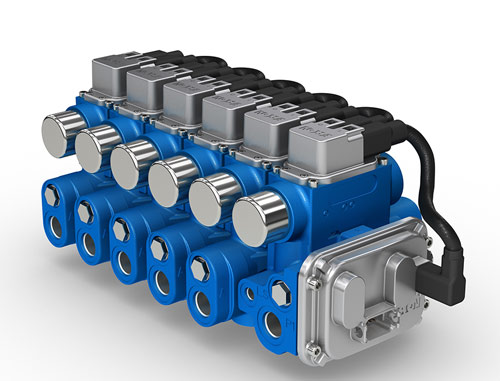Hydraulic valves operate most commonly in one of three ways; mechanical/manual control, pilot control or electric control. Mechanical control involves something physical pushing on the valve, such as with a roller or cam, which itself shifts the spool or poppet. Manual control was long the king of valve control, especially with mobile hydraulics; they’re inexpensive and easy to use. Pilot control is more complex, and requires a pilot valve to shift it, so it’s usually limited to high flow or high pressure valves.
Electronic control of hydraulic valves has been gaining popularity for decades, and with the recent down market (but not down content) move of electronic control systems and devices, their use has accelerated. Just like with consumer electronics, the cost to manufacture high powered electronic components has dropped as well. So why should this matter to you?
First of all, your attachment to the mechanical lever should have ended the same time you got over your blankie. Some people just can’t get over the loss of a manual backup to their hydraulic valves, but they’re needed no more than a lever is to back up the finger swipe control on your grandson’s iPhone. Not only are electronics dirt cheap, they’re also extremely reliable. I never pay the extra coin for the extended warranty at the electronics store, because let’s face it, I haven’t had a device break down since I pulled the channel knob off my tube TV trying to tune in Knight Rider.
I’ll admit, you can get a lever valve for less than a hundred bucks, and that’s darned cheap. However, you can get a solenoid valve and a toggle switch for just as cheap. Granted, a lever valve can be metered to accurately control flow rate, and a solenoid valve is just on and off. However, just like other electronics, electro-proportional control of solenoid valves has become inexpensive as well.
An inexpensive proportional valve can be had from HydraForce, Sun et al for not much more than your lever valve. These “prop valves” are simply valves with metering notches on the spool, and coils that can vary their magnetic field based on the current provided them. Something must take your input signal and convert it to something usable by the prop valve, which is where valve controllers come in. They take the 4-20mA, 0-10v or other signal and convert it to the Pulse Width Modulated input the valve can use. These controllers used to be quite expensive, but have been reduced drastically like the rest of the world of electronics. A combination of valve and controller can be had for a few hundred dollars, which although more than a lever valve, still provides variable flow control.
There is a caveat to inexpensive electro-proportional valve and controller systems, of course; their performance falls in line with their price. These valves just aren’t made for high performance systems, and that’s okay, because they suite their purpose. Their coil strength is often low, with high hysteresis, poor frequency response and non-linear performance. They are susceptible to performance variances due to changes in inlet pressure and actual pressure drop. Higher-end valves are superior in most of these qualities, and have further benefits like on-board electronics or spool position feedback. But if you’re replacing a lever valve, you’re probably not picky.
I like a lever valve just as much as the next guy, but they should only be used where an electrical signal does not exist, like a logsplitter or 1965 Ford tractor. And let’s face it, even your old tractor could run two 6 volt batteries in series to control any 12 volt solenoid valve. Nobody is going to ignore your mistrust of the internet and force you to sign up to online banking (which you should), but perhaps it’s time to get on board with electric control of hydraulics.
Filed Under: Mobile Hydraulic Tips
